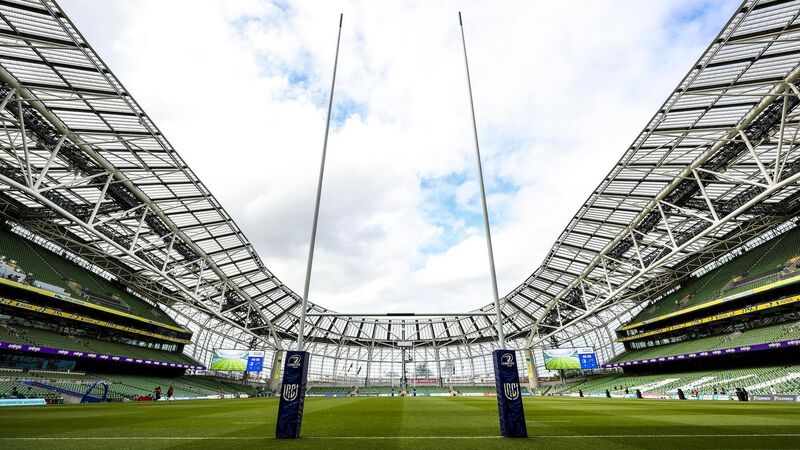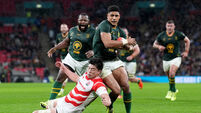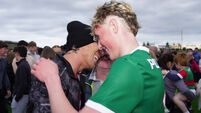Michael Moynihan: Can we define Ireland's cities in sporting terms?

Aviva Stadium in Dublin, home of soccer and rugby in Ireland. But how do you define Dublin in sporting terms?©INPHO/Ben Brady
Last week yours truly trekked from Cork up to Limerick a couple of times for press calls. Couple of weeks ago it was Dublin, and before that Waterford.
It’s been quite a while since I was in Galway, probably for a hurling league game a couple of years ago. It was a couple of years before that I saw Derry last, and it must be all of a decade or more since I found myself in Belfast.
Why am I enumerating the cities of Ireland? I confess it’s partly to do with a piece I saw in The Athletic by Michael Walker: the headline said it all: ‘Is Champions League host Paris a football city?’ Walker’s piece is well worth a read - he starts it by finding the neglected grave of Jules Rimet of World Cup fame - but of course it started me thinking.
Is Dublin/Cork/Waterford/Limerick/Galway a football/hurling/soccer/rugby city?
There are inherent flaws in the process, naturally enough. To take the original of the species, Paris has a metropolitan area population of over two million people with diverse interests, but more to the point the city is an acknowledged leader in the arts, fashion, cuisine and tourism, among other fields. Perhaps sport is the least of its concerns.
Likewise Dublin, which in an Irish context is so large - with a population of 1.1 million - as to be difficult to reduce to a single interest.
It’s been the dominant force in Gaelic football over the last decade, but it’s also been the power in the land in Irish rugby through Leinster (I nearly said the power in the continent until one of our colleagues here on the sports desk decided otherwise last Saturday). And half of the teams in the SSE Airtricity League of Ireland come from Dublin, so there’s that to consider as well.
Go to the other extreme and it’s far easier to isolate a single sporting focus: Kilkenny’s sporting interest is known the length and breadth of the country, but at a population of just under 27,000 that’s an entire urban area which would be swallowed up in one of Dublin’s discrete neighbourhoods.
The Kilkenny-Dublin comparison is a fruitful one, because one of the quartiers of the capital with a population approximating that of Kilkenny could genuinely be called a one-sport suburb.
Residents around Dalymount Park would no doubt claim their zone as Bohemiantown, while a few miles to the east the denizens of Marino might refer to their home place as Vincentville. This is a template that might be applied to other sections of other cities, but Dublin is the one with a population large enough to carry the comparison to its fullest point.
Funnily enough, there seems to be a faint reluctance among some sports when it comes to planting their flag on a particular territory. The designation of - well, the entire island, it appears - as Rugby Country a few years back didn’t meet with universal approval, for instance, and I say that with due understatement.
Granted, that antipathy may have had more to do with the commercial force behind the idea of Rugby Country - the same organisation, need I remind you, which tried to create a new holiday based on its founder’s name. (This is all so cloak-and-dagger I’m lost - a reader. What’s Google for, just the closing times of car parks? Do some work - me.)
Then there’s the simple effect of demographics. As a population ages out in one part of a city does the link to a particular sport wither and fade? Or does the new population find a new passion and convert the area to a different faith?
Many thanks to Michael Walker for starting the conversation. If you have thoughts on same by all means get in touch.
The terrible shooting in Texas during the week drew plenty of headlines, though on the grounds of severity rather than novelty: nineteen children and two adults were killed by a gunman in Uvalde, Texas.
It was notable that one of the key contributions on the horrific news was from a sportsperson - Steve Kerr, coach of the Golden State Warriors in the NBA was emotional when discussing the shooting at a regularly scheduled press conference, prefacing his remarks by saying he wasn’t going to talk about basketball.
“When are we going to do something?” said Kerr, slamming his hand down on the table. "I'm tired. I am so tired of getting up here and offering condolences to the devastated families that are out there. I am so tired of the, excuse, I am sorry, I am tired of the moments of silence. Enough!"
Viewers of The Last Dance documentary will be aware that Kerr’s father was murdered by terrorists in Beirut in 1984, which may make an event like Uvalde resonate even more for him, but he’s long been vocal on social issues, like several other basketball coaches such as Gregg Popovich.
What is it about basketball coaches in the US that makes them so vocal compared to other sports and other coaches?
I’m aware that this could lead to long and winding conversations about the levels of social awareness about coaches and managers, with an emphasis on the long and winding, but it’s an interesting way to approach your evaluation of sports figures and could reveal more than you might think.
In the old German military academies there was a long-running debate on what was best for prospective officers - to focus entirely on military theory and tactics to the exclusion of all other topics, or to give them a rounded education in several subjects and not just matters military?
Likewise, do you prefer your sports figureheads to be totally focused on sport or to have a wider context for their opinions? I know which I’d prefer.
Lester Piggott passed away over the weekend at the age of 86. Curiously, I would have imagined the great jockey to be a lot older - he seemed to be a gnarled veteran already when I became vaguely aware of him in the late seventies and early eighties.
Even then he was synonymous with his sport. In recent days experts in racing have pointed out that he was the first great jockey of the TV age, a recognisable figure even in a crowded field, a man whose lined face expressed the strain of making weight at five foot eight.
Those hawklike features signified horseracing to a generation of us, or to those, like me, who knew no more about horse racing than his name. What other sportsperson can say the same?
The holidays are on the horizon - maybe closer, depending on your nine to five - and I think I found one that’ll have to make the trip. The Church of Baseball: The Making of Bull Durham: Home Runs, Bad Calls, Crazy Fights, Big Swings, and a Hit is film director Ron Shelton’s account of making the movie Bull Durham.
It’s a movie about baseball, but don’t be downhearted. As Shelton himself says, “The biggest mistake a sports movie can make is to have too much sports,” and that’s not the case with Bull Durham. Recommend.
*Contact: michael.moynihan@examiner.ie


